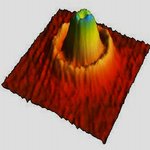
In a collaboration between the Institut für Quantenoptik (IQ) and the Institut for Fysik og Astronomi (IFA) our group contributes to the investigation of mixed quantum gases and their dynamics. The experiment is located at the Leibniz Universität Hannover.
The experiment follows two distinct research paths, involving different mixtures of quantum gases:
One part of the project is the investigation of mixed samples of rubidium and potassium atoms. This research contributes to the understanding of a large family of atomic and molecular systems, with exciting prospects for future experiments. It paves a path towards ultra-cold chemistry and one can envision the use of cold molecules for molecular optics, molecular interferometry and a molecular quantum computer.
The second part of the project, which is currently pursued, involves the investigation of mixtures of spin states of a single atomic species and its dynamics. This is commonly called spinor dynamics, and is closely related to magnetism in solid state physics. The interaction of the atoms can lead non-classical states that can only be explained with the help of quantum mechanics. These states are the starting point for a variety of investigation, such as effects of vacuum fluctuations or spontaneous symmetry breaking.
More information on the IQ website.

Interferometers with atomic ensembles constitute an integral part of modern precision metrology. However, these interferometers are fundamentally restricted by the shot noise limit, which can only be overcome by creating quantum entanglement among the atoms. We used spin dynamics in Bose-Einstein condensates to create large ensembles of up to 104 pair-correlated atoms with an interferometric sensitivity -1.6 dB beyond the shot noise limit. Our proof-of-principle results point the way toward a new generation of atom interferometers. (10/2011)

Spin-changing collisions may lead to the parametric amplification of matter waves. This behaviour may be modified by magnetic dipole-dipole interactions, although they are typically very weak in alkaline atoms. We show theoretically that they play a very relevant role and also analyze the important role of magnetic-field gradients. These must be carefully controlled in future experiments, to observe the effects of the dipolar interactions in the amplification dynamics. arXiv:1005.2011 and Phys. Rev. A 82, 053608 (2010)

Parametric amplification of quantum fluctuations constitutes a fundamental mechanism for spontaneous symmetry breaking. In our experiments, a spinor condensate acts as a parametric amplifier of spin modes, resulting in a twofold spontaneous breaking of spatial and spin symmetry in the amplified clouds. Our experiments permit a detailed understanding of the twofold symmetry breaking mechanism. arXiv:1007.2342 and Phys. Rev. Lett. 105, 135302 (2010)

Parametric amplification of vacuum fluctuations is crucial in modern quantum optics, enabling the creation of squeezing and entanglement. We demonstrate the parametric amplification of vacuum fluctuations for matter waves using a spinor F=2 87Rb condensate. The system provides a direct path towards the generation of non-classical states of matter on the basis of spinor condensates. Phys. Rev. Lett. 104, 195303 (2010)